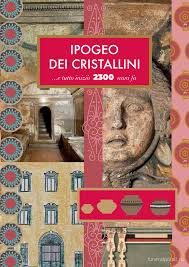HISTORY
/https://tf-cmsv2-smithsonianmag-media.s3.amazonaws.com/filer_public/62/83/6283447b-5312-453f-928b-c7e8ea7cd164/dsc_0701.jpg)
A small stretch of an ancient cemetery in Naples is set to open to the public for the first time, shedding new light on the Italian city’s history and ancient Greek artistry. Ipogeo dei Cristallini
The Ipogeo dei Cristallini’s well-preserved tombs will open to the public as soon as summer 2022
In Naples’ Sanità district, mopeds hurtle along cobbled streets dotted with larger-than-life markets as locals and visitors alike form around-the-block lines for some of the world’s best pizza.
Some 2,000 years ago, this lively Naples neighborhood was a very different place. Situated just outside the walls of Neapolis — the Greek city so respected that even under the Romans, its Hellenistic culture was allowed to flourish — it was once a hilly area composed of volcanic tuff rock.
Tuff is famously soft. For centuries, civilizations on the Italian Peninsula have dug into it to sculpt tombs, places of worship and even cave-style dwellings. The Sanità is no different: Ancient Neapolis’ Greek residents used this area, just outside the city walls, as a necropolis. Streets now pulsating with life were, back then, river-carved paths between hillocks of tuff. As the Greeks built grand family tombs, those paths became improvised roads in a city of the dead.
/https://tf-cmsv2-smithsonianmag-media.s3.amazonaws.com/filer_public/71/d1/71d1e469-9e9f-4d37-a2b5-62303d3ed7b4/archivio_dellarte_pedicini_fotografi_de0261.jpg)
View of the lower burial chamber in tomb C, one of four set to welcome visitors later this year Archivio dell’arte, Pedicini fotografi
Eventually buried by a series of natural disasters, the necropolis’ exact size is unclear. But Luigi La Rocca, head of the Soprintendenza, a government department tasked with overseeing Naples’ archaeological and cultural heritage, says it would have featured “dozens” of tombs. Multiple bodies were laid to rest in each tomb; whether they belonged to families or members of cultural and political groups remains unknown.
In use from the late fourth century B.C.E. to the early first century C.E., first by the Greeks and then the Romans, the archaeological site is “one of the most important” in Naples, according to La Rocca. Later this year, a small stretch of the long-lost cemetery is set to open to the public for the first time, shedding new light on Naples’ history and ancient Greek artistry.
Until the 1960s, when the sewer system was overhauled, the valley where the Sanità is located was subject to floods of the so-called lava dei vergini, or “lava of the virgins”: not the volcanic lava that devastated nearby Pompeii, but mud and rocks dislodged from the porous hills during rainstorms. Though the Romans reused the necropolis after the Greeks, flooding soon blanketed it in layers of sediment. Centuries later, in the 1500s, the Sanità district rose above this sea of mud.
The four soon-to-be-unveiled graves lie almost 40 feet below Via dei Cristallini, the street that houses the aristocratic di Donato family’s 19th-century palace. Each of the tombs consists of an upper chamber, where Roman funerary urns sit in niches above benches carved for Greek mourners, and a lower burial chamber, where bodies were laid to rest during the Hellenistic period. Both were filled with statues, perhaps of ancestors, and sculpted eggs and pomegranates—symbols of resurrection. In ancient times, the upper chambers were road level, while the burial spaces were underground.
/https://tf-cmsv2-smithsonianmag-media.s3.amazonaws.com/filer_public/03/1c/031c34f0-2347-4687-8bea-38572002d5d2/b18425e7-e3e4-41e6-b394-c5a5da7a92e9.jpg)
Experts are unsure exactly who was buried in the necropolis, but names scribbled in ancient Greek on the tombs' walls offer clues to the deceased's identities. Ipogeo dei Cristallini
/https://tf-cmsv2-smithsonianmag-media.s3.amazonaws.com/filer_public/30/5f/305f8d10-276e-4f1b-815e-f0f7db5544f4/0cac860b-2614-4cae-8878-e3de9bd5e18e.jpg)
“The incredible thing about this site is that it was all scavato—dug out,” says restorer Melina Pagano. “They didn’t take the beds and put them there—they carved [the room and its contents] from the hillside.” Ipogeo dei Cristallini
Christened the Ipogeo dei Cristallini, or Hypogeum of Cristallini Street, by modern observers, the tombs’ walls are frescoed with garlands, trompe l’oeil paintings and names scrawled in Greek—a roll call of the dead. In the best-preserved chamber, a gorgon keeps a watchful eye, ready to ward off enemies for all eternity.
“It feels very emotional, descending into the bowels of a city that’s so alive up above, and seeing something as they left it in the first century,” says La Rocca. The site was one of the first he visited after taking up his post in 2019, keen to see if there was any way of opening it up to the public.
“The tombs are almost perfectly conserved, and it’s a direct, living testament to activities in the Greek era,” La Rocca adds. “It was one of the most important and most interesting sites that I thought the Soprintendenza needed to let people know about.” Luckily, the site’s owners were already on the same page.
Workers probably stumbled onto the tombs in the 1700s, when a hole drilled in the garden above destroyed the dividing wall between two chambers. Quickly forgotten, they were officially rediscovered in 1889, when Baron Giovanni di Donato, ancestor of the current owners, dug in the garden in search of a water source for his palazzo.
/https://tf-cmsv2-smithsonianmag-media.s3.amazonaws.com/filer_public/5c/94/5c94ed1d-f0a8-4259-940f-2a35a8e60856/entrance.jpg)
In the late 19th century, archaeologists removed around 700 ancient objects from the tombs. Mimmo Jodice
By then, the Sanità had undergone multiple transformations: from a necropolis of Magna Graecia, or Greek-settled southern Italy, to an impoverished suburb outside the walls of the by-then-Italian Naples, to a ritzy enclave below the Bourbon royal palace of Capodimonte, perched at the summit of the tuff hill above.
Aware he’d discovered something significant, the baron had the burials privately excavated, building a staircase down from the palace courtyard. Archaeologists removed most of the roughly 700 objects found inside, including funerary urns, ceramics and statuettes; the family kept some and donated the rest to the National Archaeological Museum of Naples (MANN) and the Soprintendenza for safekeeping. Local historians studied the site, recording invaluable descriptions of the tombs’ wall paintings, which have since deteriorated. They also recovered human remains of unclear origin; today, the tombs are peppered with bones that will be studied to ascertain their owners’ age and medical history before being interred in a separate cemetery.
The tombs spent the next 120 years locked behind the nondescript cellar door of the di Donatos’ courtyard. Other than the odd word-of-mouth visit, they were inaccessible to the public. Thanks to Alessandra Calise, who married into the family, that will soon change.
Calise brought guests to the site every so often. “But then 20 years ago,” she says, “we went to the MANN to see ‘our’ room [where the Cristallini finds are exhibited], and I was overcome with emotion. It was clear that it was important to open it.”
After a decade spent outside of Naples, Calise and husband Giampiero Martuscelli—a hotelier and an engineer, respectively—made plans for the site’s public debut. In 2018, they successfully applied for regional funding and persuaded the Central Institute for Conservation (ICR), an Italian government agency, to oversee the project.
/https://tf-cmsv2-smithsonianmag-media.s3.amazonaws.com/filer_public/45/18/45187dbd-4c64-4cfa-8983-142d5dc05d88/burial_chamber.jpg)
Workers probably stumbled onto the tombs in the 1700s. Mimmo Jodice
/https://tf-cmsv2-smithsonianmag-media.s3.amazonaws.com/filer_public/92/fb/92fb6567-bae8-4483-91a8-67247fb0f6c8/steps.jpg)
Twelve painted steps lead into the lower burial chamber. Mimmo Jodice
It’s a unique site, says Federica Giacomini, who traveled from Rome to supervise the ICR’s investigations.
“Ancient Greek painting is almost completely lost—even in Greece, there’s almost nothing left,” Giacomini adds. “Today we have architecture and sculpture as testimony of Greek art, but we know from sources that painting was equally important. Even though this is decorative, not figurative painting, it’s very refined. So it’s a very unusual context, a rarity, and very precious.”
MANN director Paolo Giulierini agrees. As the caretaker of thousands of objects from Pompeii, he is keenly aware of what he deems an “imbalance” in how Naples and its neighbors are perceived. Though the ruins of Pompeii and Herculaneum may lead modern observers to view the area as a typically Roman region, Giulierini argues that Neapolis was “much more important” than those other two towns—a Greek center of excellence that “stayed Greek until the second century C.E.”
What’s more, he says, the quality of the Cristallini tombs is so exceptional that it confirms Neapolis’ high standing in the Mediterranean region. They are closest to painted tombs found in Alexander the Great’s home territory of Macedonia, meaning they were “directly commissioned, probably from Macedonian maestros, for the Neapolitan elite.”
“The hypogeum teaches us that Naples was a top-ranking cultural city in the [ancient] Mediterranean,” Giulierini adds.
/https://tf-cmsv2-smithsonianmag-media.s3.amazonaws.com/filer_public/ff/89/ff89d61f-1462-4549-a2a0-e70fb97a4879/b8fcfe50-f337-497b-96d0-88886b83f5a9.jpg)
“Ancient Greek painting is almost completely lost—even in Greece, there’s almost nothing left,” says Federica Giacomini. Ipogeo dei Cristallini
/https://tf-cmsv2-smithsonianmag-media.s3.amazonaws.com/filer_public/dd/86/dd863ff4-4111-455c-a25f-98661bcb67ad/img_3311.jpg)
The burials are comparable in quality to painted tombs found in Alexander the Great's home territory of Macedonia. Ipogeo dei Cristallini
Tomb C is the best preserved of the four, with fluted columns on either side of its entrance. Twelve scarlet-painted steps lead down to the burial chamber, where six hollow, hip-height sarcophagi—sculpted out of tuff in the shape of beds—rest on a red-and-white floor. The beds’ carefully sculpted legs are painted with geometric and floral motifs in bright scarlets, mustards and dark blues; the still-plump pillows (also made of tuff) lain on top of each sarcophagus sport stripes of yellow, violet and turquoise, with red hatchings imitating cross-stitched threads sewing them together.
These were highly prized colors, says restorer Melina Pagano, pointing to the Egyptian blue and ocher used to paint the pillows. Pagano and her colleagues at ROMA Consorzio have experimented with the conservation process by cleaning tiny sections of the rock cushions with a laser.
“The incredible thing about this site is that it was all scavato—dug out,” she says. “They didn’t take the beds and put them there—they carved [the room and its contents] from the hillside.”
The only thing not scavato in the chamber is the life-size head of a gorgon, sculpted from dark rock (possibly limestone) and fixed onto the wall opposite the door.
/https://tf-cmsv2-smithsonianmag-media.s3.amazonaws.com/filer_public/a9/db/a9db43f6-5316-47d3-889d-b85f17b682ef/archivio_dellarte_pedicini_fotografi_de0261c.jpg)
A close-up view of the gorgon sculpture Archivio dell’arte, Pedicini fotografi
Still caked in mud (for now), the mythological monster has kohl-rimmed eyes, rosy cheeks and hair that curls into full-faced serpents at the ends. She hovers over the dead, ringed by a bright halo of painted blues, yellows and reds. Miniature gorgons carved on the Ionic columns seemingly propping up the chamber double as “magical” symbols of protection, according to Giulierini.
Other surprises are hidden within tomb C’s wall paintings: lush garlands that appear to hang from the columns, ancient ritualistic dishes and vases beside flaring candelabras, and what appear to be laurel bushes. The art even features two tiny, blink-and-you’ll-miss-them figures: the god Dionysus and Ariadne, the woman he made immortal, watching over Neapolis’ dead. Ancient Greek names scrawled on the walls above the beds list the people who were likely buried there.
The paintings were in better condition when they were first discovered. During the 19th-century excavations, workers drilled four holes to air out the tombs, inadvertently letting in the lava dei vergini as it continued to flood the area. What appear to be early attempts to clean the mud in tomb A also damaged the wall paintings, says Giacomini.
Next steps for the team include covering the four holes (but not closing them, as that would destabilize the environment) and continually monitoring temperature and humidity levels. By June, the researchers should have a year’s worth of data, enabling them to begin restoring the paintings and exploring a partial opening of the site.
“This isn’t a site which you restore, make beautiful and then open,” Giacomini says. “It’ll be a continual work in progress and will need constant monitoring and maintenance.”
/https://tf-cmsv2-smithsonianmag-media.s3.amazonaws.com/filer_public/58/1b/581b39d1-0c35-4e90-9093-798fbf9b0a6a/archivio_dellarte_pedicini_fotografi_de0261i.jpg)
Six hollow, hip-height sarcophagi—sculpted out of tuff in the shape of beds—rest on a red-and-white floor. Archivio dell’arte, Pedicini fotografi
/https://tf-cmsv2-smithsonianmag-media.s3.amazonaws.com/filer_public/c1/32/c1320a28-6a1d-4cc4-820a-55225d9981db/sfasd.jpg)
View of upper burial chamber, where funerary urns sit in niches above benches carved for mourners Archivio dell’arte, Pedicini fotografi
The experts, who have already commissioned 3-D maps of the tombs, plan to carefully monitor how visitors’ presence affects the temperature and humidity, which have so far remained stable, with only seasonal variation. Lighting is also crucial: One of the main reasons the hypogeum has survived so well is because of its lack of natural light, which encourages the growth of biological organisms. (High-intensity lights damaged the famed cave paintings at Lascaux in France, which have been closed to the public since 1963.)
Despite these potential pitfalls, everyone involved in the project is determined to share the site with the world.
“[Art restorers] don’t want places perfectly conserved but invisible,” says Giacomini. “This visit will show the colors and the sophistication [of Magna Graecia]; it’ll teach people their origins in a way that’ll enrich everyone. You can’t conserve heritage for its own sake—the real challenge is finding a balance to make it live.”
La Rocca agrees, explaining, “We know the difficulties but we need to show it. We’ll evaluate it continuously—if it turns out having even ten visitors damages it, we’ll go to plan B, a multimedia reconstruction.”
Tentative plans would see the first visitors arriving in summer 2022. The MANN, meanwhile, will display its Cristallini finds in a “Napoli Antica” section slated to open in October. The Soprintendenza, for its part, is working to understand more of the site’s history. In conjunction with Vanvitelli University in nearby Caserta, staff excavated piles of earth that had been dislodged by the original excavations, uncovering the stone head of a satyr and fragments of ancient pillars dated to the third century B.C.E.
For Calise, who describes herself as a “custodian” rather than owner, opening the site to the world is a huge responsibility. “I love and respect the Sanità,” she says. “This isn’t about us. ... We’re just taking care of it for Naples.”
smithsonianmag.com









